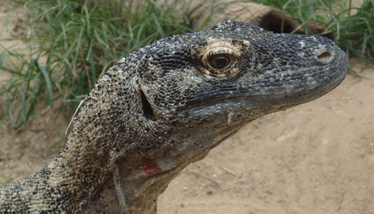Here Be Dragons
Antimicrobial peptides unearthed in Komodo dragon plasma provide the inspiration for potential new antibiotics

Komodo dragons have dirty mouths. It’s not that they swear like sailors, but rather that their saliva is teeming with pathogenic bacteria. And though dental hygiene (or lack thereof) is no longer thought to be the only source of its deadly bite (the discovery of venom glands has fueled a little-known debate in reptile research circles...), the monitor lizard does need to be capable of recovering from nasty septic wounds inflicted by competing dragons, which is thought to have led to a particularly robust immune system.
Could dragon’s blood, just like in some legends, be a source of medicine – or, at least, a source of pharmaceutical agents? Potentially yes, according to researchers behind a recent paper (1), who discovered 48 novel potential cationic antimicrobial peptides (CAMPs) with a custom bioprospecting approach. CAMPs play an essential role in the innate immune response, so interest in finding new peptides – and better understanding their role – has ramped up of late because of growing concerns over antimicrobial resistance.
Using one of the peptides they discovered as inspiration, the team then designed a synthetic peptide they dubbed DRGN-1. The compound significantly enhanced healing when testing on mice with infected wounds, by promoting the clearance of polymicrobial infection (2).
We’re some way off Komodo monitor-derived therapeutics – but, if ever a new pharmaceutical company wishes to target a certain (fantasy-board-game-playing, Game-of-Thrones-watching) subset of the population, “Dragon Drugs Inc” is a sure winner...
- BM Bishop et al., “Discovery of Novel Antimicrobial Peptides from Varanus komodoensis (Komodo dragon) by Large Scale Analyses and De Novo-Assisted Sequencing using Electron Transfer Dissociation Mass Spectrometry’, J Proteome Res, Article ASAP (2017). DOI: 10.1021/acs.jproteome.6b00857
- EMC Chung et al., “Komodo dragon-inspired synthetic peptide DRGN-1 promotes wound-healing of a mixed-biofilm infected wound”, NPJ Biofilms Microbiomes, 3, (2017). DOI:10.1038/s41522-017-0017-2

Rich Whitworth completed his studies in medical biochemistry at the University of Leicester, UK, in 1998. To cut a long story short, he escaped to Tokyo to spend five years working for the largest English language publisher in Japan. "Carving out a career in the megalopolis that is Tokyo changed my outlook forever. When seeing life through such a kaleidoscopic lens, it's hard not to get truly caught up in the moment." On returning to the UK, after a few false starts with grey, corporate publishers, Rich was snapped up by Texere Publishing, where he spearheaded the editorial development of The Analytical Scientist. "I feel honored to be part of the close-knit team that forged The Analytical Scientist – we've created a very fresh and forward-thinking publication." Rich is now also Content Director of Texere Publishing, the company behind The Analytical Scientist.















